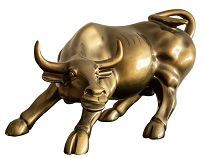Market & Money: Open the Flood Gates: Here Comes the Gold Bull

Article by Jason Stevenson on Market & Money
I came into the business bearish on the gold price. My view wasn’t widely accepted, at all. There was a fair bit of hate mail…
And, while my view has changed today, I originally turned bearish in July 2012. I was working for ex-Goldman Sachs partners at the time. I remember the day well. European Central Bank Chairman Mario Draghi said he would do ‘whatever it takes’ to save the euro.
He then printed trillions of euros…
The truth hurts
Gold crashed for three years following this statement:
Remember, prior to this event, the US Federal Reserve saved America during the Global Financial Crisis of 2008/09. Former-Chairman Ben Bernanke announced his money printing policy in late 2008.
Money printing had never been tried in history. It was, and still is, an unknown experiment. But, if the central bank did nothing, the entire banking system could have collapsed. That’s what happened during the Great Depression of 1929.
Some say: to hell with the banks. Let them go under! But, having spent years analyzing the Great Depression, I disagree.
Money printing is an artificial way to restore faith in the financial system. It provides time for governments to fix the problems.
But few issues have been addressed.
The government is at fault for not making the hard decisions. For example, it should have enforced stricter rules on the banks. It could have put a framework in place to prevent a bigger financial crisis in the future. It didn’t…
Nothing has changed
The Fed made the right decision. But, it kept interest rates at near zero levels for way too long. It also should have unwound its money printing program years earlier. So, thanks to these two grave errors, the Fed has laid the seeds for an even bigger financial crisis.
That doesn’t sound good for much, other than gold…
Remember, the US stock market bottomed 6,469 points in March 2009. That was a few days before the G20 provided a US$5 trillion stimulus package on 2 April. Yet, with the US having solved its problems (temporarily), the risk shifted to Europe in late 2009. Greece started having issues repaying its national debt.
Its sovereign debt was downgraded to junk (worthless) on 27 April 2010.
The sovereign debt crisis spread across Southern Europe during 2011–12. Portugal, Italy, Greece and Spain — dubbed the PIGs — looked like defaulting on their national debts. That’s what happened in the early 1930’s, mind you.
Confidence in the financial system was in meltdown mode.
The gold price was flying through the roof:
Mario Draghi realized that he needed to do something - at least, temporarily - to restore the faith in the financial system. That’s why, when he said he would do whatever it takes to ‘save the euro’, gold started to crash.
What has changed?
Gold bottomed in mid-December 2015. It happened two days before the US Federal Reserve raised interest rates for the first time in nearly a decade. The rate hike reversed the course for gold.
It shouldn’t be a shock. Higher interest rates add pressure to the financial system:
The US’ national debt has doubled since the Global Financial Crisis of 2008. Yet, at the same time - with interest at near-zero levels - interest payments have jumped by a mere 42%. If rates skyrocket over the next few years, interest payments should explode on the US national debt.
According to Martin Armstrong - a legendary macro forecaster - accumulated interest accounted for 60% of the US national debt in 2009. That was when interest rates were at near zero-levels. When interest rates were around 4.5% in late-2007, accumulated interest was 70% of the US national debt:
Remember, while interest rates stayed at near-zero levels, the US national debt has doubled since 2009. Martin Armstrong hasn’t updated his chart to reflect this change. Imagine if he did! The US Fed Funds rate has jumped from almost zero to around 1.82% today:
If interest rates keep surging at their current pace, the US national debt could explode by 2020. Remember, adding to the total debt level, higher US fiscal deficits are necessary to fund the payments.
More interest - and at higher rates - will be charged on the total debt in the future. It’s a double-edged sword…
The bottom line: it probably won’t end well for much, other than gold. Gold could be on the verge of a major bull market.